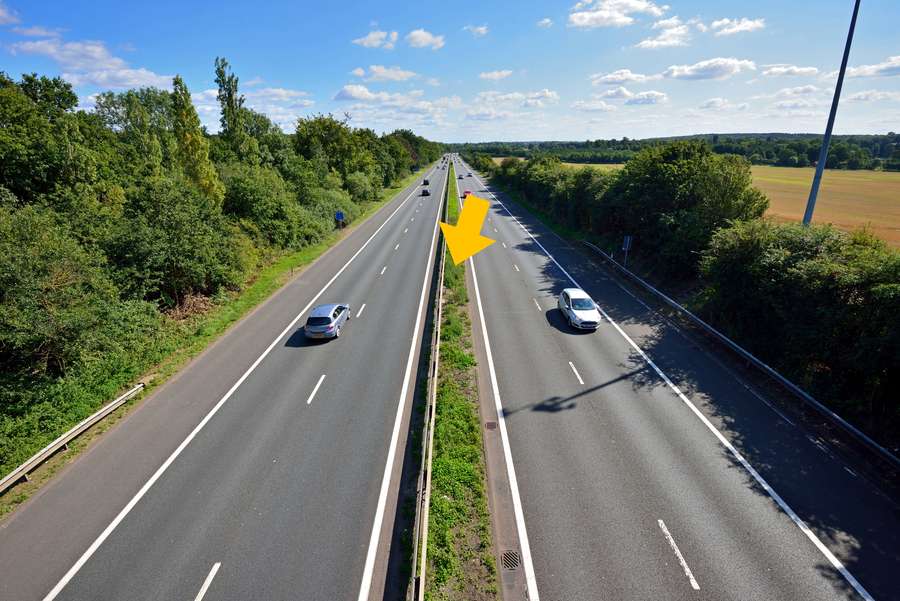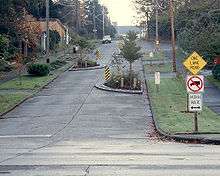| Word | Definition |
|---|---|
| fall on/upon somebody/something | To attack or assail someone or something suddenly and forcefully. |
| carriageway | A part of a road or highway designed for vehicles, typically one side of a divided highway. |
| greater prominence sign | A road sign designed to be more noticeable to alert drivers to important information. |
| steep hill downwards | A hill with a sharp decline, requiring careful driving due to the angle of descent. |
| steep hill upwards | A hill with a sharp incline, requiring increased engine power and careful driving. |
| broader line | A thicker line on a road surface indicating special instructions or boundaries. |
| slow out of control vehicles down | Measures or signs intended to reduce the speed of vehicles that may be difficult to control. |
| abutment wall | A supporting structure for a bridge or arch, providing stability and support. |
| pushed for time | In a hurry or under time pressure. |
| engine cut-out switch | A switch that turns off the engine in an emergency situation. |
| final drive chain | The chain in a vehicle that transfers power from the transmission to the wheels. |
| pulling away / start moving | The action of a vehicle beginning to move from a stationary position. |
conspicuous | Easily seen or noticed; attracting attention. |
| Your steering is likely to seize up | Your ability to steer will likely become difficult or impossible, often due to mechanical failure. |
| dipped headlights | Headlights aimed lower to prevent dazzling other drivers. |
| Dipped | Headlights in their lowered, non-dazzling position. |
| Harsh braking | Sudden and forceful application of the brakes. |
| pillion passenger | A passenger who sits behind the rider on a motorcycle. |
| cable-operated clutch | A clutch that is engaged and disengaged using a cable mechanism. |
| laden weight | The total weight of a vehicle, including its cargo and passengers. |
| hard shoulder “emergency lane” or “breakdown lane.” | The reserved area on the side of a road for emergency stops or breakdowns. |
| diversion | A route that drivers are directed to take when the usual road is closed or blocked. |
- Traffic-calming refers to a set of measures and techniques implemented to slow down and reduce traffic speed, improve safety, and create a more pedestrian-friendly environment.
- lay-by - A paved area at the side of a highway designated for drivers to stop in, for emergency parking, or where vehicles can wait, with larger lay-bys possibly having facilities like food vendors or public telephones
- Road studs are sometimes called “cat’s eyes” due to their resemblance to the reflective structure of a cat’s eye. The term “cat’s eyes” was coined by Percy Shaw, a British inventor who developed the reflective road studs in the 1930s. He was inspired by the way a cat’s eyes reflect light at night, providing excellent visibility in the dark.
- The term “diverted traffic” can be translated into Russian as “перенаправленное движение”. It refers to the temporary redirection or rerouting of traffic due to road closures, construction work, accidents, or other events that necessitate altering the regular flow of vehicles.
- It is generally advisable for motorcyclists to consider wearing gear that enhances their visibility and makes them more
conspicuousto - a “diversion” sign typically indicates a temporary change in the normal route or direction of traffic. It is often used when there is road construction, an accident, or any other situation that requires traffic to be rerouted or redirected away from a specific area.
Important terms
buffeting from other vehicles - refers to the turbulent or turbulent air movement created by the motion of nearby vehicles, typically when they are traveling at high speeds. This phenomenon often occurs on highways or other roads with fast-moving traffic.
central reservation
central reservation - the strip of land between the carriageways of a motorway or other major road.

chicane
A chicane is a serpentine curve in a road, added by design rather than dictated by geography. Chicanes add extra turns and are used both in motor racing and on roads and streets to slow traffic for safety

more
- Until it starts to turn in: This phrase means “up to the point when the vehicle begins to turn.” For example, “Keep going straight until it starts to turn in.”
- Pull over: This means to stop at the side of the road, usually because it is required by law. For example, “The police officer signaled for the driver to pull over.”
- Pull up: This means to stop your vehicle at a particular spot by your choice, like a parking space or a designated area. For example, “She decided to pull up in front of the store to pick up some groceries.”
- Pull out: This means moving from a stopped position into traffic. For example, “He pulled out into the busy street.”
- Pull in: This means moving a vehicle from a driving position to a stopped or parked position, usually at the side of the road, in a parking space, or at a destination. For example, “I need to pull into the gas station.”
- Not to hold up the traffic: This means to avoid delaying or obstructing the flow of traffic.
- Clutch biting point: This refers to the point at which the clutch begins to engage or disengage when you press or release the clutch pedal in a manual transmission vehicle.
- Drive up: This means approaching a location or destination by vehicle. For example, “He drove up to the house.”
- Turn off: This means to leave the main road to go onto another road or into a different direction. For example, “Turn off the highway at the next exit.”
- Slip road: This is a road that allows vehicles to enter or leave a main road. For example, “Take the slip road on the right to join the motorway.”
- Take heed: This means to pay attention or be careful. For example, “Take heed of the warning signs on the road.”
- Panel warning light comes on while you’re driving: This means that a warning light on the vehicle’s dashboard illuminates while you are driving, indicating a potential issue.